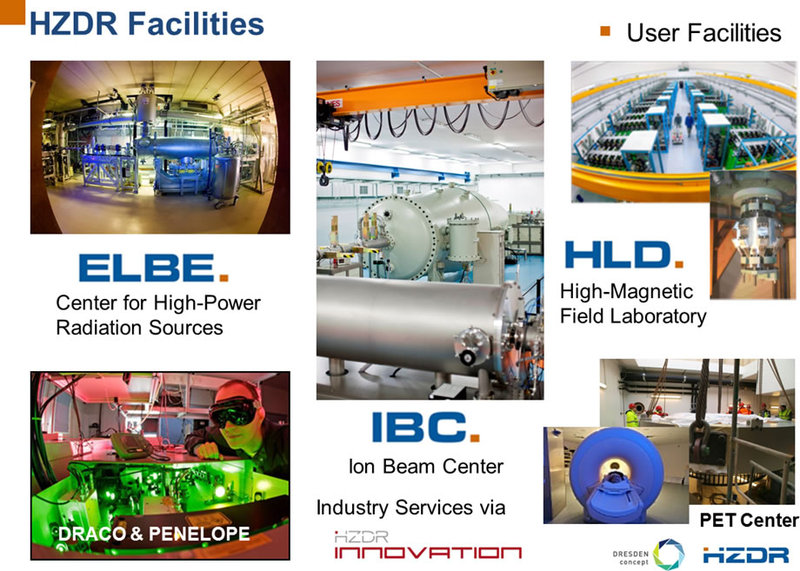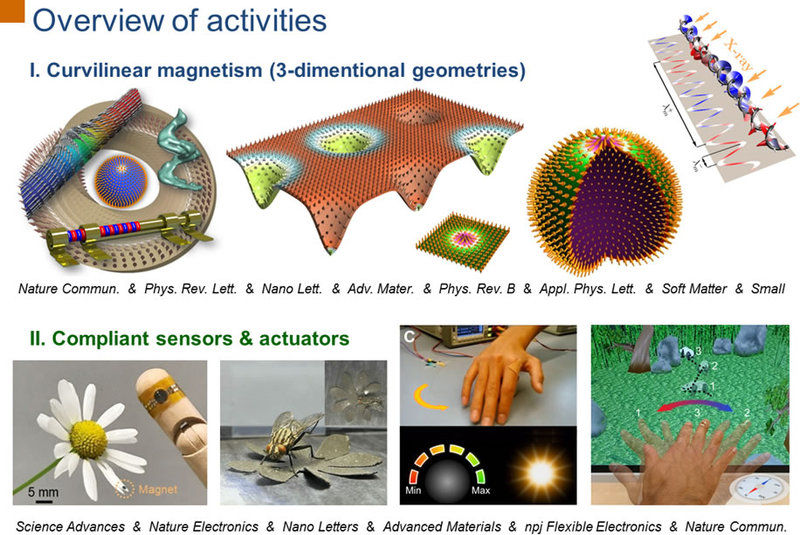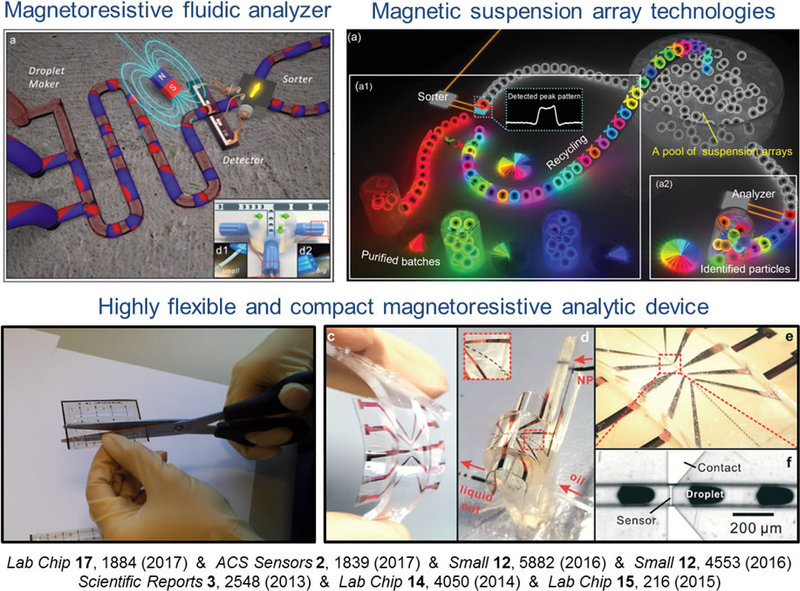Helmholtz-Zentrum Dresden-Rossendorf e.V. (HZDR)
Team
The Helmholtz-Zentrum Dresden-Rossendorf e.V. (HZDR) is a non-profit research organisation and a member of the German “Helmholtz Association of German Research Centers”. With around 1200 employees, it is the largest research institution in the German Federal State of Saxony, being funded by the Federal and Saxonian Governments. The eight institutes of HZDR are active in application-oriented basic research, which is focused on three major research fields matter, energy, and health. HZDR is running 3 large scale facilities including Dresden High Magnetic Field Laboratory, ELBE-Center for High-Power Radiation Sources and the Ion Beam Centre (Fig. 1).

Figure 1. Overview of large scale facilities at the HZDR including ELBE (Center for High-Power Radiation Sources), HLD (High-Magnetic Field Laboratory) and IBC (Ion Beam Center). All these facilities are user facilities. In addition HZDR runs a daughter company – HZDR Innovation GmbH – which is a frontend of the institute to work with industry partners.
1. Ion Beam Center (IBC) at HZDR combines various machines (electrostatic accelerators, ion implanters, other ion- and plasma-based equipment) into a unique facility mainly used for ion beam modification and ion beam analysis of materials. The available energy range varies from 10 eV to almost 100 MeV with a respective interaction depth in solids between 0.1 nm and 10 µm. The IBC represents one of the worldwide leading infrastructures for the investigation of ion-surface interaction and the application of ion technologies in research and industry.
2. Dresden High Magnetic Field Laboratory (HLD), is one of the sites of the ESFRI landmark EMFL. It is operated as a user facility for experiments in ultra-high pulsed magnetic fields up to 90 T. The following experimental techniques are available in pulsed fields: Electrical transport, Magnetization, Ultrasound, Electron Magnetic Resonance (ESR and CR), Magnetostriction, NMR, Magnetic torque, Magnetocaloric effect.
3. ELBE–Center for High-Power Radiation Sources that provides an electron beam of high brilliance and low emittance. This primary beam can generate various kinds of electromagnetic radiation and particle beams, which also are available for experiments: Free-Electron Laser (FELBE) -coherent electromagnetic radiation in the wavelength between 4-250 µm; Bremsstrahlung (up to 20 MeV); the direct electron beam from ELBE that can be used for detector tests and for irradiation; neutrons (nELBE) - a neutron time-of-flight system with neutron energies between 100 keV and 10 MeV; positrons (pELBE), and superradiant THz source (TELBE).
HZDR takes part in the Helmholtz Energy Materials Characterization Platform (HEMCP), a distributed national research infrastructure approved in 2013 and funded by the German Federal Ministry of Education and Research, the German Federal Ministry for Economic Affairs and Energy and the Helmholtz Association, with its ion beam center being the only facility providing ion beam technology to users from the energy sector. In addition, HZDR hosts the Helmholtz Institute Freiberg for Resource Technology (HIF) dedicated to the development of innovative technologies for the efficient and environmentally friendly extraction of mineral and metalliferous raw materials.
Principal Investigators
| Dr. Denys Makarov (PI at the HZDR) obtained his Master Degree (2005) at the National University of Kyiv in Ukraine, followed by a Ph.D. (2008) from the University of Konstanz in Germany. From November 2010 until September 2015 Denys Makarov was leading a group “Magnetic Nanomembranes” at the Leibniz Institute for Solid State and Materials Research Dresden (IFW Dresden), Germany. From October 2015 until June 2019 he was head of research group “Intelligent materials and devices” and ERC group “Shapeable magnetoelectronics” at the HZDR. Since July 2019, Denys assumes the position of head of department “Intelligent Materials and Systems” at the HZDR. Dr. Makarov has pioneered the field of magnetism on curved surfaces and has opened up with this the field of spintronics on flexible, bendable and stretchable surfaces (Fig. 2). For the development of this novel research field Denys Makarov was awarded grants from the European Union (ERC Starting Grant in 2013, ERC Proof-of-Concept Grants in 2014 and 2017, EU FP7-ICT Grant in 2014) as well as national funding agencies (German Research Foundation (DFG), Federal Ministry for Economic Affairs and Energy (BMWi), Federal Ministry of Education and Research (BMBF)). Denys is a Senior Member of the IEEE and a Fellow of the Young Academy of Europe. He co-authored more than 150 papers (H-index 41, i10-index 106), has 6 granted patents and gave more than 90 invited talks. D. Makarov obtained more than 13 Mio EUR of external funding. |

Figure 2. Overview of activities of the group of Dr. Makarov at the HZDR. We address fundamental aspects of how geometrical curvature affects electro-magnetic responses of thin films with strong emphasis on their magnetic properties. This fundamental know-how we use to develop novel types of highly compliant magnetic field sensors and soft actuators.
Regarding the activities pursued in the frame of the BioNanoSens project, Denys Makarov with his team made a decisive contribution to the development of the droplet-based magnetofluidic platforms for detection and analytics (Fig. 3) encompassing integrated novel functionalities, e.g. analytics in a flow cytometry format, magnetic barcoding and sorting of magnetically encoded emulsion droplets. He put forth a novel high-capacity indexing scheme based on multiphase microfluidic networks for large-scale screening applications and realized flexible microfluidic platform with integrated magnetoresistive sensorics. These features are crucial to address the needs of modern medical research, e.g. drug discovery.

Figure 3. Overview of the activities of the HZDR group on digital magnetofluidics.


 This website reflects only the authors’ view. The European Union is not liable for any use that may be made of the information contained herein.
This website reflects only the authors’ view. The European Union is not liable for any use that may be made of the information contained herein.